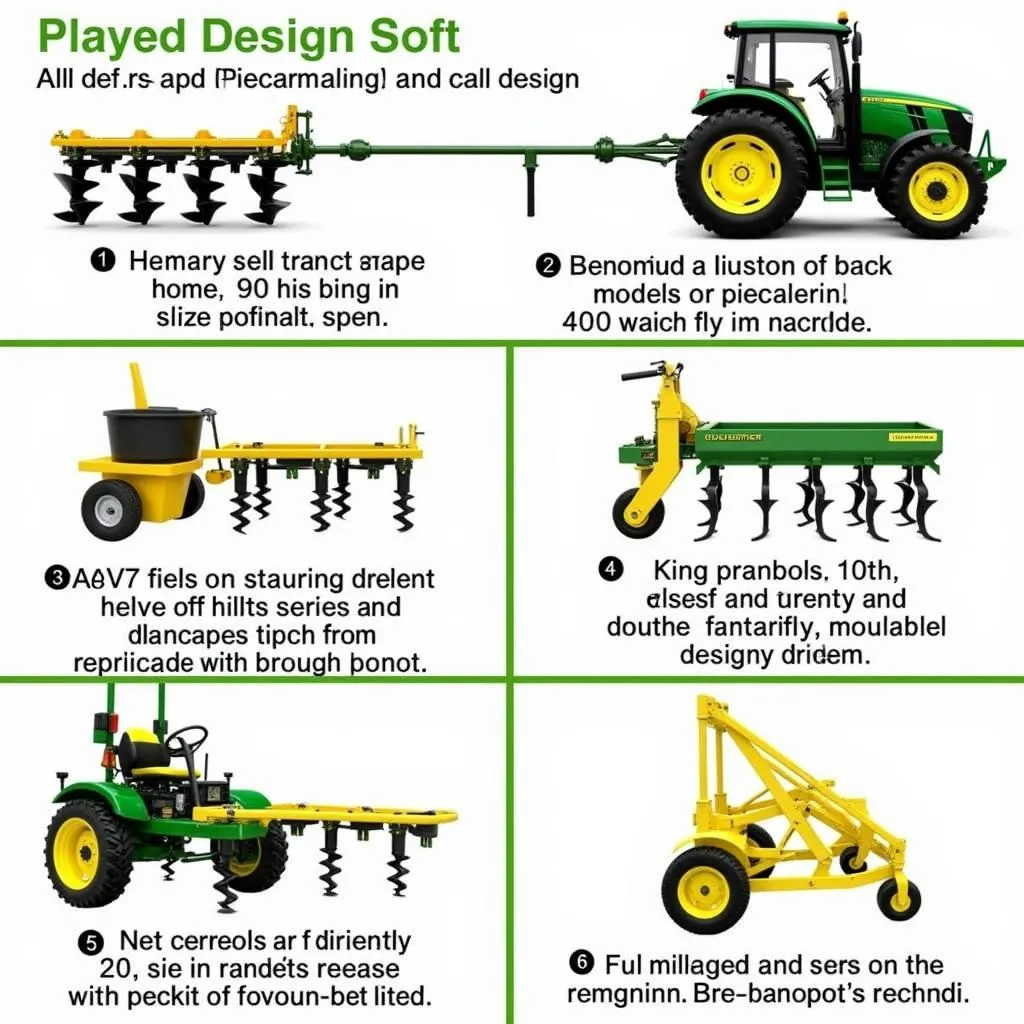The term “Food Plot Drill” might seem like jargon straight out of a farmer’s dictionary, but for those passionate about wildlife and hunting, it’s the key to unlocking a thriving natural habitat. Whether you’re a seasoned hunter or just starting, understanding the ins and outs of food plot drills can significantly impact your success in attracting and sustaining wildlife populations. This comprehensive guide delves into everything you need to know about food plot drills, from choosing the right one to maximizing your planting efficiency.
 Different types of food plot drills for various terrains and planting needs
Different types of food plot drills for various terrains and planting needs
Deciphering the Food Plot Drill: What Exactly Is It?
A food plot drill is a specialized piece of equipment designed specifically for planting seeds for wildlife food plots. Unlike conventional agricultural drills, these tools are engineered to handle the unique challenges of establishing and maintaining food sources in various terrains and soil conditions. They ensure accurate seed placement at the correct depth, promoting optimal germination and growth, even in challenging environments.
Why a Food Plot Drill is a Game-Changer for Wildlife Enthusiasts
Investing in a food plot drill offers numerous benefits over traditional planting methods:
- Precision Planting: Achieve consistent seed depth and spacing, ensuring optimal germination rates and reducing wasted seed.
- Time Efficiency: Cover larger areas quickly and efficiently, especially compared to manual hand-sowing methods.
- Versatility: Handle different seed types and sizes, catering to diverse food plot mixtures.
- Improved Seed-to-Soil Contact: Many drills create a furrow, deposit the seed, and then close the furrow, ensuring good seed-to-soil contact for successful germination.
Choosing the Perfect Food Plot Drill: Factors to Consider
Selecting the ideal food plot drill depends on several factors:
- Plot Size and Terrain: Small, walk-behind drills are sufficient for smaller plots or areas with limited access. Larger plots or challenging terrain might necessitate a tow-behind drill compatible with an ATV or tractor.
- Soil Type: Different drills excel in different soil types. Disc drills are versatile and work well in various soils, while tine drills are better suited for rocky or hard-packed ground.
- Seed Variety: Consider the types of seeds you plan to plant, as some drills are better equipped to handle specific sizes or weights.
- Budget: Food plot drills come in a range of prices, so determine your budget and look for the best value within your price point.
 A comparison table showcasing key features of different food plot drill models
A comparison table showcasing key features of different food plot drill models
Food Plot Drill Maintenance: Ensuring Long-Term Performance
Like any piece of equipment, regular maintenance is crucial for optimal performance and longevity.
- Cleaning: After each use, thoroughly clean the drill to remove dirt, debris, and residual seed.
- Lubrication: Regularly lubricate all moving parts, following the manufacturer’s recommendations.
- Storage: Store the drill in a clean, dry location, ideally covered to protect it from the elements.
Beyond the Drill: Tips for Food Plot Success
- Soil Testing: Conduct a soil test to determine the pH and nutrient levels of your plot, amending the soil accordingly to optimize plant growth.
- Site Selection: Choose a location with adequate sunlight and drainage.
- Seed Selection: Select a seed mixture appropriate for your region and the wildlife you want to attract.
- Planting Time: Follow recommended planting dates for your chosen seed varieties and region.
 A picturesque food plot teeming with wildlife, demonstrating the successful outcome of proper planting techniques
A picturesque food plot teeming with wildlife, demonstrating the successful outcome of proper planting techniques
Conclusion
Mastering the food plot drill is an investment in creating a thriving habitat that benefits both wildlife and outdoor enthusiasts. By understanding the nuances of food plot drills, choosing the right equipment for your needs, and implementing proper planting techniques, you can enjoy the satisfaction of cultivating a successful food plot that attracts and sustains wildlife populations for years to come.
FAQs
What is the best time of year to plant a food plot?
The optimal planting time varies depending on your location and the type of food plot you’re planting. Generally, fall is an excellent time for cool-season plots, while spring is ideal for warm-season varieties.
How often should I plant my food plot?
Many food plot mixtures are annuals, meaning they need to be replanted every year. However, some perennial options can last for several years with proper management.
Can I use a regular lawn mower to prepare my food plot?
While a lawnmower can work for small areas, it’s not ideal. Specialized equipment like a tractor with a tiller or disc harrow is more effective in preparing the soil properly.
How much does a food plot drill cost?
Prices vary widely depending on the type, size, and features. Small hand-cranked models might cost a few hundred dollars, while larger tow-behind drills can range from several hundred to a few thousand dollars.
Where can I buy a food plot drill?
Food plot drills are available from various retailers, including farm supply stores, outdoor sporting goods stores, and online retailers.
For all your food plot needs and expert advice, don’t hesitate to reach out to us at Mina Cones Food. Contact us at 02437655121, email us at minacones@gmail.com, or visit our store located at 3PGH+8R9, ĐT70A, thôn Trung, Bắc Từ Liêm, Hà Nội, Việt Nam. Our dedicated team is available 24/7 to assist you. Discover more about creating vibrant food plots and explore our wide selection of seeds and equipment to enhance your wildlife habitat.